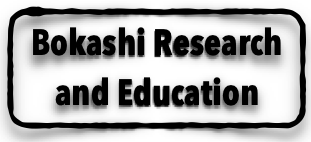Ingredients
Ingredients (main and optional)
Blackstrap molasses comes from the sugar cane where the sugar cane juice is boiled three times. After the third boiling, what remains is blackstrap molasses. It is rich in minerals, such as potassium, calcium, and iron.
... view moreEM•1 Microbial Inoculant
(EM: Effective Microorganisms)
EM•1 is the liquid containing the three groups of microbes that define EM, Effective Microorganisms: lactic acid bacteria, yeast, and photosynthetic bacteria. The species of microbes listed in each group below are
... view moreWhile in countries where rice is more of a staple crop than wheat, rice bran would be a main ingredient in making bokashi sprinkles. In countries, such as the U.S., wheat bran is more readily accessible or is at least cheaper.
... view moreThe sea salt you can use can be regular, inexpensive sea salt, such as Mediterranean Sea Salt, either course or fine crystals. It is evaporated sea water and little processed retaining trace minerals. These minerals and other possible substances in sea salt help to stabilize and give Activated
... view moreThe water used to make any of the recipes can be tap water, filtered water, or distilled water.
The microbes in EM can withstand up to three times the chlorination of tap water.
... view moreWheat bran is the outer layer, the hull or husk, of the wheat grain.
Use animal-feed grade wheat bran, which costs less than food grade wheat bran.
Animal-feed grade wheat bran can be found at animal feed supply stores, such as Agways. They typically sell them in 50-lb
... view moreIngredients (alternative materials)
Alternative materials: 6
Brewer's spent grain is a waste product from breweries. It can be used for various purposes, including using it as an organic material in making the bokashi sprinkle.
If the spent grain is relatively fresh (less than a day old), then it could be used as is, without drying, since the
... view moreCacao or cocoa husks are the outer shell or outer layer of the cacao bean. Cacao beans or cocoa beans are the seeds inside of the cacao fruit (also, cacao pod), each containing 20–60 seeds, from the cacao tree, Theobroma cacao.
Cacao husks are a waste product from chocolate
... view moreCoconut coir (coconut fiber) comes from the outer husk of the coconut. It is used as a natural material for making various products, and is also used as mulch or other purposes in gardening or farming. It can also be used, if shredded into a loose material, as an organic material in making the
... view moreCoffee chaff is the outer husk that comes off of coffee beans during the roasting process. It is a waste product and can be gotten for free from a coffee roaster. You'll need to contact them and ask if you can have their coffee chaff. You'll then need to pick it up from them.
Coffee chaff
... view moreLeaves, particularly fall leaves (autumn leaves), should be completely dry before using it as an organic material for making bokashi. Any moisture can harbor microbes that can interfere with the bokashi fermentation and result in something that smells like low tide. The leaves should therefore
... view moreWood shavings or saw dust, either from a wood furniture maker or lumber yard/store, can be used to make the bokashi sprinkle.
However, here are some considerations:
- Use only shavings and saw dust from untreated wood.
- Certain wood types can be fermented, including
